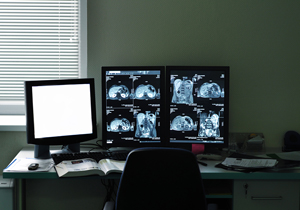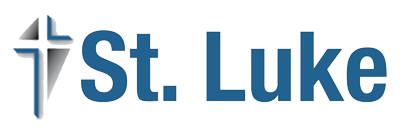
Picture of a radiology room that has computer monitors up of MRI images.
Radiological Services
Radiology
MRI
CT Scan
Nuclear Medicine
Ultrasound
Dexa Scans
Mammography
St. Luke Hospital Radiology
General Radiographic Services

Radiology Staff (L-R): Dena Liggett, Katie Ens, Robyn Miller, Jamie Angel
(X-ray)
At St. Luke Hospital we have one fixed combination Radiographic/Fluoroscopic (R&F) unit and one mobile radiographic unit.These units are used in a variety of ways to include orthopedic (Bone) imaging to studies of the upper gastrointestinal region (Upper GI).
The mobile x-ray unit is used to provide imaging at the patient's bedside, in the Emergency Room and, on occasion, in the operating room.

G.E. OEC 8800 Mobile C-Arm (Mobile Fluoroscopy unit for Surgery)
St. Luke Hospital recently purchased and installed a mobile fluoroscopy unit for use primarily in surgery.The 8800 C-arm is designed for use in situations where instantaneous imaging is needed such as in surgical gallbladder cases, bone repair and vascular studies.
The OEC 8800 is a valuable addition to our imaging department and will enhance our abilities in the operating room.
Back to top
St. Luke Hospital MRI
MRI (Magnetic Resonance Imaging) Services
At present St. Luke Hospital utilizes the services of Shared Medical Services, a mobile provider using a G.E. 1.5 Tesla MRI Unit.MRI Services are provided by Shared Medical Services on every Tuesday morning starting at 7:00am. We receive excellent service from Shared Medical Services.
Back to top
GE LightSpeed CT Scanner

Patient Benefits:
Automated dose-reduction features
Breathing lights help patients remain motionless during scans
Less time needed for breath-holds, resulting in less stress to the patient
Greater flexibility (e.g., obtain thinner or thicker slices without rescanning the patient)
Full CT Angiography coverage
Better cross-sectional displays and 3D images
Clear images aid improved patient diagnosis
Fast, accurate scan times mean faster patient exams
Captures heart images in a single breath-hold

Physician Benefits:
Full suite of applications to assist in examination of the abdomen, spine & chest
Variable-speed scanning-rotation speed can be adjusted in increments of 0.1 seconds, giving clinicians an unprecedented degree of control over procedures. Variable scan speeds allow clinicians to image patients with a variety of heart rates, giving doctors more control to meet a specific clinical need.
Scans as fast as 0.5 seconds. Higher-speed scanning means clearer, sharper images with fewer artifacts caused by patient movement.
CT exams that used to take up to 40 minutes can now be completed in approximately 20 seconds allowing the speed and accuracy needed to quickly diagnose a variety of conditions for emergency and non-emergency patients of all ages.
CT Technologist Benefits:
Highly automated operation-designed for single-technologist operation. The imaging process is so automated that the operator only needs to choose from a list of scan protocols, plan the scan and push start. The system reconstructs, films, networks and archives automatically.
Productivity and ergonomic enhancements-features that save technologists time and steps, and enhance patient comfort include:
Remote gantry tilt (from inside the control room)
In-room start (from inside the exam room)
Front and back gantry controls
Patient breathing lights
IV pole and instrument tray that move with the patient
table

The LightSpeed CT scanner from GE Medical Systems lets clinicians complete extremely fast exams while tailoring image quality, anatomic coverage and scan speeds to meet patient and application needs.
The GE LightSpeed was introduced in 1998 as the world's first multi-slice scanner. It provides clinicians with a unique feature called variable-speed scanning, which offers greater flexibility to customize patient procedures and perform new types of patient exams. When combined with new acquisition techniques, variable-speed scanning can capture fast-moving images of the heart for cardiovascular studies. The features also allow doctors to perform other studies, such as those for neurology, oncology, trauma and angiography. Along with new procedures, doctors have the flexibility to customize protocols for each unique patient, which enhances productivity and image quality.
GE's proprietary HiLight Matrix Detector technology reduces X-ray technique, lowers patient dose, and provides better image quality and higher patient throughput. This 16-row, 912 channel detector captures more anatomical information per second than single-slice scanners-thanks to fundamental breakthroughs in ceramics science and electronics engineering. It can also be used for expandable slice acquisition for future growth.
The Performix tube is made of stainless steel metal and provides proven reliability and precision, with an average lifespan of 21 months and counting. With more than 3,000 LightSpeed Systems installed worldwide, more doctors choose GE LightSpeed than any other multi-slice CT Scanner.
LightSpeed CT Scans Typically Include the Following Procedures:
Routine chest, abdomen & pelvis scans
Skeletal joint studies
Angiography studies
Trauma/emergency room situations
Stroke assessment
Oncology/cancer care
Pulmonary emboli
Inner ear ailments
Spinal injuries
Abdominal injuries
Pediatric assessment
Kidney exams
Liver exams
Lung exams
Back to top
St. Luke Hospital Nuclear Medicine
Nuclear Medicine Department
At St. Luke Hospital we utilize a General Electric Millenium MPR Single Head multi-purpose Nuclear Medicine camera.The Millenium was installed in the radiology department in February of 2006 and has revolutionized how we deliver healthcare to our patients.
The Millenium provides the department with the advanced technology to provide a wide range of nuclear diagnostic studies to include general imaging studies such as: Full Body Bone scans, Hepatobiliary studies (Gallbladder Function), and cardiac applications such as Gated Radionuclide Venticulography for assessing the output of the ventricles of the heart and Stress/Rest Cardiac studies to assess coronary artery disease.
Patient preparation for most Nuclear Medicine studies is as easy as not taking anything by mouth for a minimum of 6 hours. Because we are working on a metabolic level when performing nuclear medicine examinations, most studies will require that the patient receive an intravenous injection of a mildly radioactive solution.
The patient will receive detailed instructions when being scheduled for a nuclear medicine study and in some cases will receive a telephone call the day before by a member of the radiology department to ask questions about current medications and any other related health issues you may have that could have the potential to interfere with your scheduled exam.

JR Ewing
Back to top
Dexa Scans
Dexa stands for Dual Energy X-Ray Absorptiometry. It is the most commonly used test for measuring bone mineral density. It is one of the most accurate way to diagnose Osteopenia or Osteoporosis. These tests can be performed Monday - Friday during business hours.Back to top
St. Luke Hospital Ultrasound
Ultrasound Services
St. Luke Hospital is proud to offer in house Ultrasound services. We have a full time technologist on staff that is registered in a wide array of exams, from vascular to general ultrasound, we've got you covered. Special services are also offered on Wednesday mornings for Breast Imaging with the Radiologist and Echocardiograms are performed in house on Monday and Thursday afternoons.
Robyn Miller
Back to top
St. Luke Hospital Mammography
Mammography Department
To provide the highest level of care to our patients, St. Luke has added digital mammography to our women's health services.We have chosen the Selenia Dimensions digital mammography unit from Hologic because we believe it offers the best technology available.
Mammograms are offered four (4) days a week by our trained technologist with extended late hours available upon request. Call (620) 382-2177 ext. 153 to with any questions or to schedule your appointment today.
The mammography unit is certified by the Food and Drug Administration (FDA) and by the American College of Radiology (ACR). The FDA requires that the mammography department comply with all the rules and regulations stipulated by the Mammography Quality Standards Act (MQSA) of 1992.

Keri Helmer and Katie Ens
Back to top



